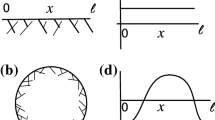Abstract
This paper considers differential problems with random switching, with specific applications to the motion of cells and centrally coordinated motion. Starting with a differential-equation model of cell motion that was proposed previously, we set the relaxation time to zero and consider the simpler model that results. We prove that this model is well-posed, in the sense that it corresponds to a pure jump-type continuous-time Markov process (without explosion). We then describe the model’s long-time behavior, first by specifying an attracting steady-state distribution for a projection of the model, then by examining the expected location of the cell center when the initial data is compatible with that steady-state. Under such conditions, we present a formula for the expected velocity and give a rigorous proof of that formula’s validity. We conclude the paper with a comparison between these theoretical results and the results of numerical simulations.



Similar content being viewed by others
References
Çınlar E (2011) Probability and stochastics. In: Graduate texts in mathematics, vol 261. Springer, New York. doi:10.1007/978-0-387-87859-1
Dallon JC, Othmer HG (2004) How cellular movement determines the collective force generated by the Dictyostelium discoideum slug. J Theor Biol 231:203–222
Dallon JC, Scott M, Smith WV (2013) A force based model of individual cell migration with discrete attachment sites and random switching terms. J Biomech Eng 135(7):071008–071010. doi:10.1115/1.4023987
Dallon JC, Evans EJ, Grant CP, Smith WV (2013) Cell speed is independent of force in a mathematical model of amoeboidal cell motion with random switching terms. Math Biosci 246(1):1–7. doi:10.1016/j.mbs.2013.09.005
Friedl P, Gilmour D (2009) Collective cell migration in morphogenesis, regeneration and cancer. Nature Rev Mol Cell Biol 10(7):445–457
Gumbiner BM (1996) Cell adhesion: the molecular basis of tissue architecture and morphogenesis. Cell 84(3):345–57
Kallenberg O (2002) Foundations of modern probability. In: Probability and its applications. Springer, New York (2002). http://opac.inria.fr/record=b1098179
Keller R, Davidson L, Edlund A, Elul T, Ezin M, Shook D, Skoglund P (2000) Mechanisms of convergence and extension by cell intercalation. Philos Trans R Soc London Ser B Biol Sci 355(1399):897–922
Krawczyk W (1971) A pattern of epidermal cell migration during wound healing. J Cell Biol 49(2):247–263
Mammoto T, Ingber D (2010) Mechanical control of tissue and organ development. Development 137(9):1407–1420
Marsaglia G (1986) The incomplete \(\gamma \) function as a continuous poisson distribution. Comput Math Appl 12(5):1187–1190
Meyn S, Tweedie RL (2009) Markov chains and stochastic stability, 2nd edn. Cambridge University Press, Cambridge. doi:10.1017/CBO9780511626630
Minassian D (2007) A mean value theorem for one-sided derivatives. Am Math Monthly 114(1):28
Rieu J-P, Saito T, Delanoë-Ayari H, Sawada Y, Kay RR (2009) Migration of dictyostelium slugs: anterior-like cells may provide the motive force for the prespore zone. Cell Motil Cytoskelet 66(12):1073–1086. doi:10.1002/cm.20411
Ross S (2004) A first course in probability, 9th edn. Pearson, Boston
Tanner K, Ferris D, Lanzano L, Mandefro B, Mantulin W, Gardiner D, Rugg E, Gratton E (2009) Coherent movement of cell layers during wound healing by image correlation spectroscopy. Biophys J 97(7):2098–2106
Uchida K, Yumura S (2004) Dynamics of novel feet of dictyostelium cells during migration. J Cell Sci 117(8):1443–1455. doi:10.1242/jcs.01015
Ulrich F, Heisenberg C-P (2009) Trafficking and cell migration. Traffic 10(7):811–8. doi:10.1111/j.1600-0854.2009.00929.x
Yilmaz M, Christofori G (2010) Mechanisms of motility in metastasizing cells. Mol Cancer Res 8(5):629–642
Acknowledgments
The authors wish to thank the anonymous referees for their helpful feedback and suggestions. A special thanks to the referee who provided the less technical proof of Lemma 4.9 that is presented in the final version.
Author information
Authors and Affiliations
Corresponding author
Rights and permissions
About this article
Cite this article
Dallon, J.C., Despain, L.C., Evans, E.J. et al. A continuous-time model of centrally coordinated motion with random switching . J. Math. Biol. 74, 727–753 (2017). https://doi.org/10.1007/s00285-016-1040-2
Received:
Revised:
Published:
Issue Date:
DOI: https://doi.org/10.1007/s00285-016-1040-2




